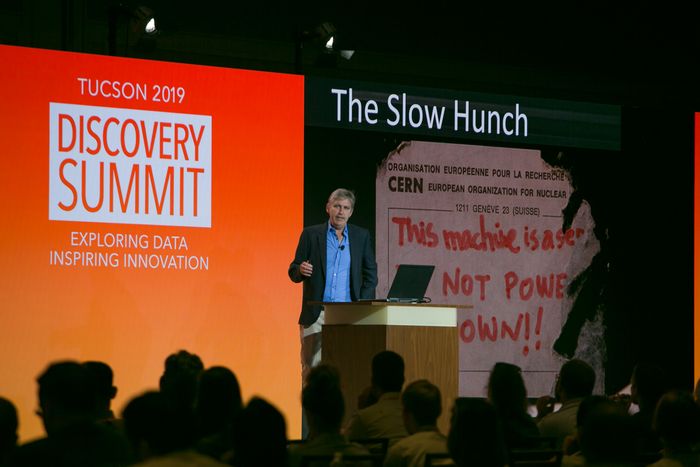 What do innovations look like in the real world? Steven Johnson identifies some common features.I've long admired the work of author Steven Johnson. In a career spanning 12 books, Johnson has examined topics related to science, culture, and technology, from a broad historical perspective. In his narratives conventional wisdom is often upended, and unexpected and enlightening connections are made. It's exhilarating to have your brain tickled in this way! That's why I was so pleased to hear Johnson give the concluding keynote speech at the Discovery Summit Tucson.
What do innovations look like in the real world? Steven Johnson identifies some common features.I've long admired the work of author Steven Johnson. In a career spanning 12 books, Johnson has examined topics related to science, culture, and technology, from a broad historical perspective. In his narratives conventional wisdom is often upended, and unexpected and enlightening connections are made. It's exhilarating to have your brain tickled in this way! That's why I was so pleased to hear Johnson give the concluding keynote speech at the Discovery Summit Tucson.
Over his long career, Johnson has told stories about innovation, about transformative ideas, about discovery. Themes that resonated deeply at Discovery Summit. For his keynote on the final day of the conference, Johnson shared some of the insights he's learned from his work in this area, and previewed some new work.
For his current project, Johnson is taking the long view: looking at transformative changes that happen in a slow and incremental way, but have had massive impacts on humankind when understood at historic scale. His primary focus is the unprecedented increase in life expectancy over the last 100 years. In 1920, shortly after the Spanish flu epidemic and the end of World War I, life expectancy was a little more than 40 years. It is now nearly double that. Many assume that this sharp increase is due to advances in medicine and healthcare, but Johnson argues that this accounts only for improvements in recent years, since 1950 or so. For much of history, medical attention was more likely to cause harm than good! We'll have to wait for Johnson's new book to learn what he thinks the most important innovations are underlying this massive change, but he hinted that many of them involve improved collection, synthesis, and analysis of data. Sounds right in our wheelhouse for JMP!
Expanding on the themes of data and progress, Johnson then turned to a topic that runs through much of his recent work: the nature of innovation. The popular model of innovation is skewed -- we are "overindexing the idea of the lone genius," he argued. In his book "The Ghost Map," Johnson retold the story of the London cholera outbreak of 1854. In the commonly told version of the tale, the heroic innovator John Snow advances a bold new theory about the waterborne transmission of cholera, overturning the then-current disease models, saving untold numbers of lives, and founding the field of modern epidemiology. According to Johnson, the true story is far more complex; it involves multiple collaborators (an affable vicar and a proto-statistician feature prominently), and the change in scientific opinion is slow, rather than a sudden breakthrough.
What do innovations look like in the real world? Johnson identified some common features.
The Slow Hunch
John Snow didn't come to the waterborne theory of cholera transmission all at once; instead it was something he had contemplated and studied for years. We are all lucky that Snow sustained his hunch until the right combination of factors enabled him to bear out his theory.
Similarly, Tim Berners-Lee didn't invent the World Wide Web in a singular "Eureka" moment -- his development efforts were a side project, proceeding in his spare time over a period of five years. At first, the project was nebulous and vague, but the idea matured slowly. A slow hunch can blossom into a true innovation over time. Johnson urged us to create and work in environments that encourage slow hunches, and allow us to keep them alive.  It's not always a Eureka moment that produces an innovation. Sometimes, a slow hunch can blossom into a true innovation over time.
It's not always a Eureka moment that produces an innovation. Sometimes, a slow hunch can blossom into a true innovation over time.
The Blind Spot
Innovators are often those who can identify and see through blind spots. Johnson recounted an amusing example from his book "How We Got to Now," about a curious device called the phonautograph. Patented in 1857 by an inventor named Édouard-Léon Scott de Martinville, this instrument allowed soundwaves to be recorded onto a rotating drum, producing a visual representation of the wave form.
Unfortunately, this device had no feature that allowed for playback of the sound! The inventor, who was trained in shorthand writing, assumed that people would be able to understand speech or appreciate music by looking at the printout, just as a stenographer can read shorthand. It would take 20 more years for Thomas Edison's phonograph to provide the ability to play back sound recordings. Were it not for de Martinville's blind spot, he might have beaten Edison to the punch.
Diverse Perspectives and Liquid Networks
In his latest book, "Farsighted," Johnson surveyed the field of decision science. One of the strongest findings in this area is that teams composed of people with diverse perspectives make objectively better decisions! Johnson calls a flexible environment that allows thinkers and ideas to react with each other "a liquid network." When slow hunches mature in the context of a liquid network, innovations can flourish.